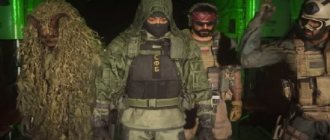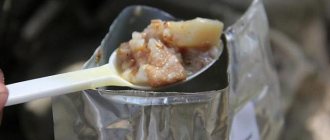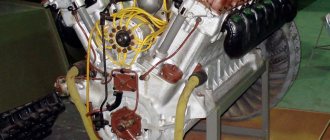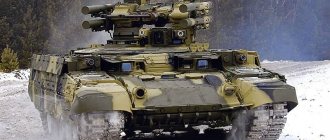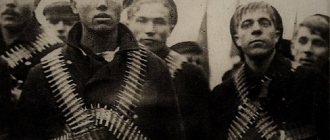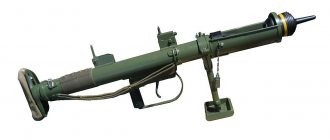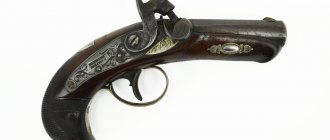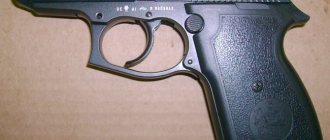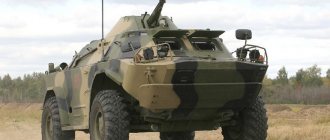5:04 / 01/23/16 Small arms: new Polish machine guns
As you know, until recently, the Polish armed forces used weapons based on the Kalashnikov assault rifle. Despite the fact that the developments around the AK were quite interesting and, in fact, they can be called a parallel branch of the development of the Kalashnikov assault rifle, it was decided to create their own weapon, not based on the AK.
The new machine gun was supposed to become not only the main weapon for the Polish army, but also become the basis for a new sniper rifle and machine gun. That is, the Polish armed forces have aimed at fully modularizing their small arms. Let's try to take a closer look at the result of the work of Polish designers, especially since the result turned out to be quite interesting.
The strange decision to abandon weapons based on the Kalashnikov assault rifle was clearly not supported by anything, since those models that were created on its basis already had little in common with the AK. As stated above, the Polish branch of AK development went its own way, the goal of which was to fully comply with NATO standards. So the only thing left from the Kalashnikov assault rifle in the latest models was the automatic one. It was also decided to build the new weapon on the basis of automation with removal of powder gases from the barrel and locking when the bolt is turned. Actually, the automation scheme was completely worked out and it was impossible to create something supernova based on it.
Comparison of weapons in the classic layout and the bullpup layout / Photo: www.madeinpolska.eu
Of much greater interest is the fact that over the past two decades, Polish designers have been rushing between the classic layout and the bullpup layout. Having not come to a final decision on which layout would be most suitable for the Polish army, it was decided to create two types of weapons in two different layouts and, depending on the situation, use one or another model. A separate requirement was the maximum interchangeability of individual weapon components with each other. This was supposed to solve the price issue of production, as well as significantly simplify the repair and maintenance of weapons.
In my opinion, the creation of identical machine guns in two different configurations is more than justified, only the distribution of such weapons should be appropriate between the branches of the military. Thus, types of troops that have special requirements for the compactness of weapons should receive a bullpup and not interfere with the classic layout in any way and vice versa. That is, if you have already picked up the “classics”, then you should not switch to a bullpup, with rare exceptions. Still, the skills of handling weapons must be developed to the point of automaticity, and due to the difference in the location of the same magazine and the displacement of the bolt handle, a delay may occur that will cost the soldier’s life.
Weapons with an under-barrel grenade launcher / Photo: www.militaryfactory.com
Despite all the efforts to make weapons in two layouts with the maximum number of interchangeable components, in field conditions without special tools it is unlikely that it will be possible to switch from one layout to another, but this is not required. Despite this, the weapon has a completely interchangeable bolt group, a barrel with a powder gas exhaust tube, weapon controls, and so on. That is, the main differences relate only to the receiver and trigger mechanism.
It is worth noting that the machine has the ability to fully adapt to left-handers. Not only are all the controls duplicated on both sides, but without special tools you can change the side of ejection of spent cartridges from the weapon, which is especially important for the bullpup layout.
Underbarrel grenade launcher on a machine gun in a bullpup configuration / Photo: www.militaryfactory.com
The location of the controls, as mentioned above, is completely identical in both versions of the machine gun, with the exception of the bolt handle. All elements are located at the same distance from the pistol grip of the weapon. So the fire mode switch is located immediately above the pistol grip. The magazine release button is located above the base of the safety clip and is pressed with the index finger of the holding hand. The bolt handle is located on both sides of the weapon and is motionless when firing. The weapon has a slide delay when all ammunition from the magazine is used up, which significantly reduces the weapon's reload time. However, the slide stop does not automatically disengage when a new magazine is inserted, apparently for safety reasons. In order to disable the shutter delay there is a separate button on the back of the receiver neck. It’s hard to say how justified this is, but since they did it this way, it means they were guided by something.
Oddly enough, the weapon was not hung on all sides with Picatinny-type mounting rails; they are only available on the top and bottom. However, it is possible to install additional seats if necessary. The main sighting devices in the form of a rear sight and front sight are installed on the upper mounting bar, and the front sight is folded.
Two disassembled machine guns in different layouts / Photo: www.militaryfactory.com
A standard under-barrel grenade launcher with a 40 mm shot caliber is installed on the lower mounting bar; a laser target, a flashlight, an additional handle for holding, or a bipod can be installed in the same place. The seriousness of the intentions of the Polish armed forces regarding this weapon can be observed at least by how much time was spent on completely fine-tuning the machine gun. So in 2010, all the work on the Radon shooting system (that’s what this whole disgrace was called, traditionally for Poland it is the same name for a chemical element or mineral) and only in 2014 they presented the final versions of the weapon under the names MSBS-5,56-K and MSBS-5,56 -B for classic and bullpup layouts respectively.
Both variants of the assault rifles have a barrel length of 406 millimeters. The total length of the classic is 900 millimeters with the stock unfolded and 670 with the stock folded. Weight is 3.65 kilograms. For weapons in the bullpup configuration, the total length is 670 millimeters, that is, the same as that of the MSBS-5.56-K with the butt folded. The weight is true lower, but not by much – 3.55 kilograms. The machine guns are fed from detachable magazines from the M16 and similar ones with a capacity of 30 rounds.
It is difficult to call this weapon completely modular until there is more specific data on the machine gun and sniper rifle based on it, however, the fact that it is possible to restore order in the weapons in this way is difficult to dispute. Most likely, we will never see data on the combat use of this weapon, so we can expect approximately the same number of flattering reviews about the weapon and far from the most unfavorable ones, because all felt-tip pens have different tastes and colors, and an adequate assessment of the weapon can only be obtained with its practical and extensive application, and not on the training ground.
When writing the material, data from open Internet sources was used:
1. Materials from the website “Material Resources Management” of the Armed Forces of the Republic of Belarus.
2. Materials from the site Made in Polska.
3. Materials from the Military Factory website/
Tags: , Poland, new assault rifles, NATO standard
“Let’s try to save money by landing!”
In the early 50s, the Polish Army had 25 combined arms divisions. Many of these formations had low combat value, so by the middle of the decade the number of divisions was reduced to 14. At the same time, the process of reorganizing infantry divisions into mechanized ones was underway, which turned out to be very costly. On the other hand, the leadership of the Department of Internal Affairs demanded that Poland provide a certain number of divisions at its disposal.
One of the ways to meet this requirement was the decision to form an airborne division (Airborne Division). This allowed significant savings, because the paratroopers did not need tanks and armored personnel carriers. The idea was first formulated in a report by the commander of the Warsaw Military District, Brigade General Józef Kuropeski, in December 1956.
Three months later, the concept of creating airborne troops in Poland was presented in Moscow, where it met with the full understanding of the Soviet comrades. From that moment on, the process went into full swing.
Emblem of the 6th Pomeranian Airborne Division Rochowicz R. Czerwone berety z Krakowa // Nowa Technika Wojskowa, 2020, No. 12
By order of the Minister of National Defense dated June 23, 1957, the 6th Pomeranian Infantry Division stationed in Krakow was renamed the 6th Pomeranian Airborne Division. The reorganization was accompanied by a significant reduction in staff. In fact, the formation was folded into a brigade, which remained in the future, proudly called a division, until the mid-80s. However, it was not easy to mislead the planners from the ATS command - in all plans, the 6th Pomeranian Airborne Division was taken into account precisely as a brigade.
The concept of using the 6th Airborne Division
Throughout the existence of the division, its main task in a possible war against the NATO bloc was a landing in Denmark, or more precisely, on the island of Zealand. True, the combat capabilities of the “red berets” were significantly limited by the very meager fleet of military transport aircraft of the Polish Air Force. To replace the obsolete S-47 and Li-2, only two An-12B aircraft and a dozen light An-26 aircraft were purchased. This was enough to ensure the daily combat training of paratroopers, but in the event of war, the landing of the 6th Airborne Division had to take place from Soviet military transport aircraft.
Units of the 6th Airborne Division before boarding An-12 aircraft dlapilota.pl
The “October Storm” exercise, held in 1965 in Poland, Czechoslovakia and the GDR, demonstrated the combat capabilities of the 6th Airborne Division. The division in its entirety, with deployed and staffed units up to wartime levels, landed in the area of Erfurt (GDR).
A total of 4,130 Polish paratroopers took part in the exercises. In addition to the already mentioned Soviet ASU-85, the 6th Airborne Division during the “October Storm” used the SKOT-1 armored personnel carrier and BRDM, temporarily transferred by other Polish units. The landing was carried out from 180 An-12 aircraft of the Soviet Air Force.
The “October Storm” became the only exercise in the entire history of the Krakow “Red Berets”, during which the landing of a division in full force was practiced. According to combat deployment plans, on the sixth or seventh day after the start of open military preparations, the 6th Airborne Division should have concentrated in one of two initial areas for loading onto aircraft. The first of the areas included the airfields of Zagan, Szprotawa and Krzywa (reserve ones - Babimost, Wschowa and Gostyn) in Western Poland, almost on the border with the GDR. The second is Klyuchevo and Chojne (reserves are Chaplinek, Miroslawiec and Nadazhiche) in the north-west of the country. The landing was supposed to take place in the areas of the east and southeast coast of Zealand. Together with the airborne assault, a naval assault force landed as part of the 7th Airborne Division. The 15th Mechanized Division was to operate in the second echelon.
In the 70s, the task of capturing the island of Bornholm, which had long remained out of sight of the ATS command, was added. For this task, the 10th Airborne Battalion and (in the second echelon) the 28th Mechanized Regiment of the 15th Mechanized Division were allocated.
Mountain training occupied a prominent place in the training of Polish paratroopers. Żołnierz Polski
Fortunately, war in Europe was avoided, and the only “combat” operation in which the units of the 6th Airborne Division had a chance to participate was the introduction of martial law in Poland in December 1981. On December 12 at 24:00, the 10th Airborne Battalion (220 people) occupied the Warsaw House of Culture and Science, as well as the Center for Polish Radio and Television. On December 13, at 6:00 a.m., planes landed at the capital's Okiecze Airport, transporting an assault company and support units of the 16th battalion from Krakow. These units took control of the airport. On December 15, two companies of the 16th battalion, remaining in Krakow, were sent to “pacify” the protesting collective of the iron and steel plant named after. Lenin, because the police could not cope with this.
In the following days, two more assault companies of the 10th battalion “worked” at this plant. Unlike the Soviet airborne troops, whose divisions had turned into mechanized formations by the 70s of the last century, the 6th Airborne Division always remained light infantry - conceptually close to American and Western European formations of similar purposes. The division, equivalent in composition to a brigade, had little firepower and limited mobility.
